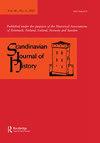Runaway Serfs in 17th-Century Estland and Livland
IF 0.8
3区 历史学
Q1 HISTORY
引用次数: 0
Abstract
ABSTRACT Adscripti glebae is a condition where peasants legally belong to a particular landholding. Its purpose was to maintain a stable labour force at the disposal of the landholder. Peasants who did not abide by this immobility requirement were termed runaways. Runaways have been episodically mentioned in medieval and early modern social history, particularly in demographic history, urban history, and histories of serfdom. Yet they have rarely been the central focus of historical studies. This paper examines the runaway on the background of the particular conditions of serfdom in the provinces of Estland and Livland. The paper describes how serfdom was practiced in these provinces, proceeds to peasant agency by considering the numerous diverse reasons for running away and outlines the reasoning behind the efforts of both nobility and government aimed at maintaining the status quo. The court records of a few extradition cases are highlighted to illustrate aspects of the issue of keeping serfs bound to the land.17世纪英格兰和利夫兰的逃亡农奴
本文章由计算机程序翻译,如有差异,请以英文原文为准。
求助全文
约1分钟内获得全文
求助全文
来源期刊

SCANDINAVIAN JOURNAL OF HISTORY
HISTORY-
CiteScore
1.10
自引率
20.00%
发文量
33
期刊介绍:
Scandinavian Journal of History presents articles on Scandinavian history and review essays surveying themes in recent Scandinavian historical research. It concentrates on perspectives of national historical particularities and important long-term and short-term developments. The editorial policy gives particular priority to Scandinavian topics and to efforts of placing Scandinavian developments into a larger context. Studies explicitly comparing Scandinavian processes and phenomena to those in other parts of the world are therefore regarded as particularly important. In addition to publishing articles and review essays, the journal includes short book reviews. Review essay proposals and polemical communications are welcomed.
 求助内容:
求助内容: 应助结果提醒方式:
应助结果提醒方式:


